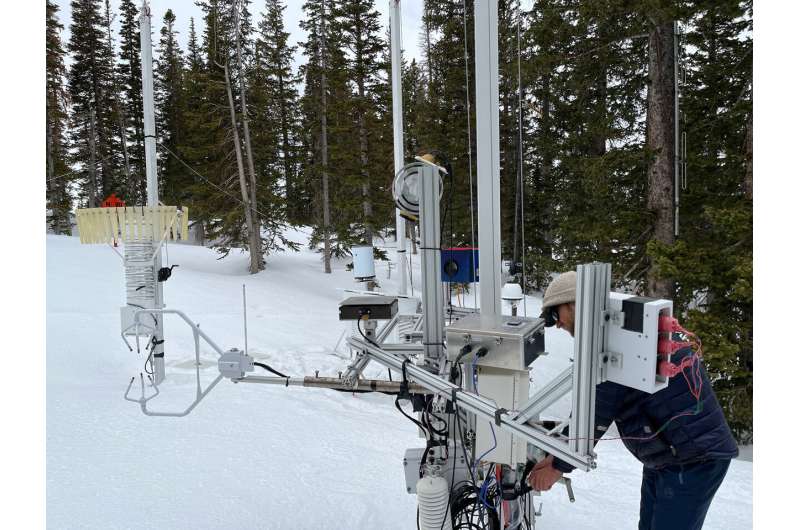At the site near Salt Lake City, researchers struggled to collect data in 900 inches of snow. Image credit: Singh et al.
A winter wonderland is reminiscent of a pile of fluffy, glistening snow. But in order to reach the ground, snowflakes are swept into the turbulent atmosphere and swirl through the air rather than falling directly to the ground.
The path of precipitation is complex, but important for skiers evaluating potential powder snow on an alpine vacation or schoolchildren hoping for some snow. Determining how fast snowflakes are falling is critical for predicting weather patterns and measuring climate change.
exist fluid physics, University of Utah researchers report the acceleration of snowflakes in atmospheric turbulence. They found that regardless of the turbulence or snowflake type, acceleration followed a general statistical pattern that could be described as an exponential distribution.
The article “A Universal Scaling Law for Lagrangian Snowflake Acceleration in Atmospheric Turbulence” was written by Dhiraj Kumar Singh, Eric R. Pardyjak, and Timothy Garrett.
“Even in the tropics, precipitation often begins as snow,” says author Timothy Garrett. “How quickly precipitation falls can greatly affect the longevity of storms, their trajectories, and the extent of cloud cover that can amplify or attenuate climate change. Small adjustments to model representations of how quickly snowflakes fall can have a major impact on the speed of storm forecasts and climate predictions. Warming at a certain level of elevated greenhouse gas concentrations.”
The team set up at a ski area near Salt Lake City, battling an unprecedented 900 inches of snow. They simultaneously photographed snowfall and measured atmospheric turbulence. They used a laser sheet device they invented to gather information about the quality, size and density of snowflakes.
“In general, and as expected, we found that low-density ‘fluffy’ snowflakes were most responsive to surrounding turbulent eddies,” Garrett said.
Despite the complexity of the system, the research team found that snowflake acceleration follows an exponential frequency distribution with an exponent of three and a half. When analyzing the data, they also found that fluctuations in the terminal velocity frequency distribution followed the same pattern.
“Snowflakes are complex, and turbulence is irregular. The simplicity of the problem is actually quite mysterious, especially given the discrepancy between changes in terminal velocity that are seemingly unrelated to turbulence and the acceleration of the snowflake when it is locally impacted by turbulence. There’s a correspondence,” said Garrett.
Since size determines the final velocity, a possible explanation is that the turbulence in the clouds that affects the size of the snowflakes is related to the turbulence measured at the ground. Yet the factor of three and a half remains a mystery.
The researchers will revisit their experiment this winter, using oil droplet fog to take a closer look at turbulence and its effect on snowflakes.
More information:
Dhiraj Kumar Singh et al., A universal scaling law for Lagrangian snowflake acceleration in atmospheric turbulence, fluid physics (2023). DOI: 10.1063/5.0173359
Provided by American Institute of Physics
citation: Snowflake acceleration mysteriously follows predictable patterns (December 19, 2023), Retrieved December 21, 2023 https://phys.org/news/2023-12-snowflake-mysteriously-pattern.html
This document is protected by copyright. No part may be reproduced without written permission except in the interests of fair dealing for private study or research purposes. Content is for reference only.
#Snowflake #acceleration #mysteriously #predictable #patterns
Image Source : phys.org
